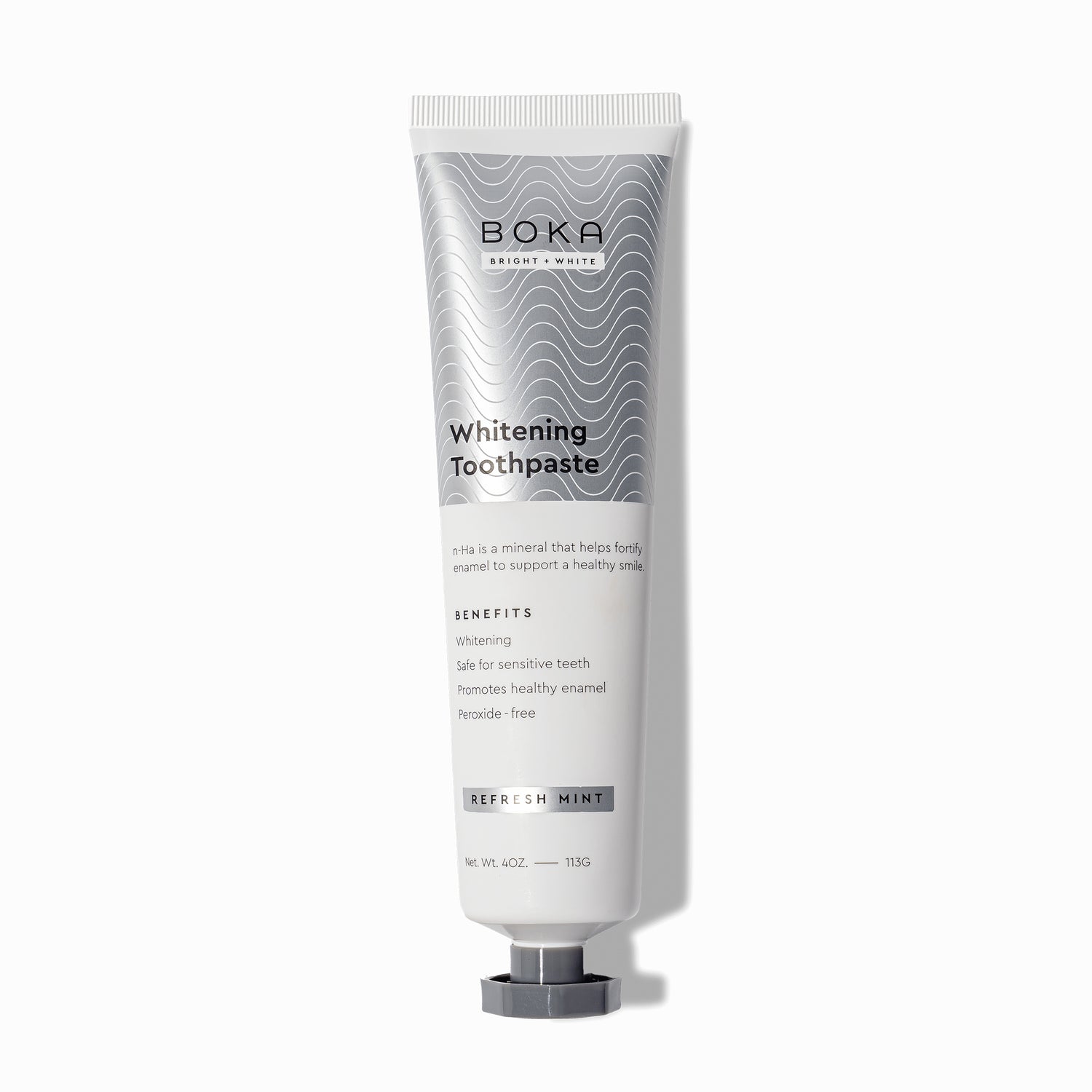The importance of maintaining good oral hygiene and brushing your teeth is beyond doubt.
It’s likely that you habitually clean your teeth morning and night, for at least two minutes, and have instilled this routine in your children!
However, when was the last time you considered the ingredients in your household toothpaste or even read the back of the tube?
Many people reach for the cheapest or most popular supermarket brand of toothpaste without giving much thought to what it’s actually made out of.
The ingredients within your toothpaste significantly impact the effectiveness of your toothbrushing and overall oral health. What’s worse is that some common toothpaste ingredients can do more harm than good!
This article outlines 6 toothpaste ingredients to avoid, as well as several beneficial alternatives to look out for. Keep reading if you wish to improve your oral hygiene routine!
Harmful Toothpaste Ingredients
Many common ingredients and additives in toothpaste may be harmful. Research has shown that certain ingredients can be detrimental to your oral health.
If you’re looking to enhance your oral hygiene routine today, the following ingredients should be avoided:
Sodium Lauryl Sulfate (SLS)
Sodium Lauryl Sulfate (SLS) is a common ingredient that causes toothpaste to foam when you brush.
However, SLS can also irritate sensitive teeth and gums! Research has shown that repeated exposure to SLS in toothpaste removes the protective mucin layers within the soft tissues of the oral cavity (mouth).
This results in ulceration of soft tissues, including the gums, inner cheeks, lips, and tongue. Mouth ulcers can be unpleasant and take over a week to heal fully.
In a pilot study conducted over a 3-month period by the Department of Oral Surgery and Oral Medicine, individuals who used a paste containing SLS saw a substantial increase in ulcers following the experiment. Conversely, there was a significant decrease in the quantity of ulcers when the patients moved to an SLS-free toothpaste.
Triclosan
Triclosan is a chemical ingredient added to many toothpastes for its antibacterial properties.
However, the safety effectiveness of triclosan for killing germs has not been proven, and research-backed evidence is limited.
Further, studies have shown that triclosan can trigger gut inflammation. On top of this, triclosan is an endocrine-disrupting chemical, meaning it can cause issues with hormone function and production.
Short-term animal studies have shown that high doses of triclosan can lead to reduced thyroid hormone levels, but it is unclear how this applies to humans.
Artificial Sweeteners
The negative effects of sugar on your teeth and oral health are well-established.
For this reason, many toothpastes use alternative sweeteners to make toothpastes taste more pleasant!
However, some artificial sweeteners also have negative side effects.
Aspartame is one of the most commonly used artificial sweeteners in conventional toothpaste, and ongoing debate has been sparked about its potential adverse effects.
Claims have been made that aspartame is possibly carcinogenic to humans, but studies have provided “limited evidence.”
In another study, aspartame has been shown to alter gut flora and raise blood sugar levels, both of which are connected to insulin resistance.
Saccharin and Sucralose are two other commonly used artificial sweeteners, with potentially negative effects. The effects of these sweeteners remain unknown until further studies are undertaken.
Propylene Glycol
Propylene Glycol is an additive used to prolong the shelf-life of many household beauty and hygiene products.
However, studies have shown that in large quantities, propylene glycol can damage the nervous system, liver, and kidneys.
This can be especially dangerous if you have underlying conditions or medical issues relating to these organs.
Propylene glycol is found in everyday products like medications, flavorings, and cosmetics. To avoid overconsumption, it's advisable to exclude it from regular toothpaste usage.
Diethanolamine (DEA)
Diethanolamine (DEA) is found in antifreeze and brake fluid – and perhaps shockingly, toothpaste!
A 1998 study discovered that topical application of DEA has been linked to cancer in animals, and can induce liver deficiency.
Therefore, it’s best to completely avoid this ingredient in your toothpaste, or any other product.
Titanium Oxide and Parabens
Titanium oxide is a tooth-whitening agent found in many toothpastes. In 2022, the EU banned the use of this ingredient in food products.
Studies have shown a link between titanium oxide and genetic damage in mice. As a result, the European Food Safety Authority suggests that titanium oxide can no longer be considered a safe additive to consumer goods.
Routine toothpaste often contains parabens to extend shelf life. Parabens mimic the effects of estrogen hormones and have been linked to endocrine disturbances and breast cancer when ingested.
What about Fluoride?
Fluoride is a controversial toothpaste ingredient.
There are ongoing debates about whether the positive effects of fluoride outweigh the negative consequences, but it is ultimately up to the individual to decide whether or not you use it, and in what quantities.
In large quantities, fluoride can cause fluorosis, which is discolored spots on the teeth. Fluorosis is not considered to be harmful to your health, and is merely a cosmetic concern.
However, fluoride may also be responsible for a number of more serious health issues, including neurological and endocrine dysfunction. A 2012 research study showed that fluoride may negatively affect cognitive development in children.
A 2006 study discovered that fluoride affects normal endocrine function.
The endocrine system controls hormone release and function within the body, which affects multiple other systems including heartbeat, bone development and growth, mood, metabolism, and more.
On a positive note, fluoride has been shown to help prevent tooth decay in individuals.
It can strengthen the surface of teeth, prevent the growth of cavity-causing bacteria, and help repair early stages of tooth decay.
Fluoride is a natural substance that exists in the air, soil, freshwater, seawater, and plants.
Certain geographic locations naturally have more fluoride present in the water and environment! Therefore, it is likely you are already getting enough fluoride to reap its benefits.
The potential consequences of ingesting too much fluoride over a long period of time have been proven, so it may be best to avoid over-consumption by keeping this ingredient out of your toothpaste.
Commonly Used Ingredients in Toothpaste Formulations
We get it: the list of harmful ingredients to avoid in your toothpaste can be overwhelming!
But beyond that, there are many other commonly-used ingredients in toothpastes that are beneficial for your oral health. Here are some of the best ingredients to look out for:
Nano-hydroxyapatite (n-Ha)
n-Ha is a form of calcium that makes up 97% of your tooth enamel and 70% of your dentin.
Because it comprises the primary foundation of teeth and bones, it's restorative for your teeth and enamel.
The remineralizing effects of n-Ha are well-documented and proven. When added to toothpaste, this magic ingredient can remineralize teeth and support enamel health without the use of fluoride, sulfates, parabens, or additives.
Boka’s range of n-Ha toothpastes contain the science-backed superstar ingredient, n-Ha, along with soothing aloe vera, bacteria-fighting xylitol, and other natural ingredients to freshen your breath, whiten teeth, and rebuild enamel!
Potassium Nitrate
Potassium nitrate is an ingredient that reduces tooth sensitivity.
A 2012 study found that toothpaste and mouthwash containing potassium nitrate significantly decreased tooth sensitivity!
Therefore, if you struggle with overly sensitive teeth, look out for this on the ingredients list when selecting a toothpaste! Keep in mind it may take a few weeks of consistent use to notice the benefits.
Zinc Nitrate
Plaque is a sticky film covering the teeth that contains harmful bacteria. Zinc Nitrate is a useful ingredient that can reduce the build-up of plaque!
A 2008 study compared a group of adults who brushed their teeth with a zinc nitrate-containing toothpaste, with a group who used toothpaste without the ingredient.
After 2 weeks, the zinc citrate group experienced a 24-52% reduction in bacteria and plaque compared to the control group.
Calcium Carbonate
Calcium carbonate is an abrasive agent that helps to thoroughly clean teeth and remove stains.
Research has shown that toothpastes containing calcium carbonate remove more plaque than toothpastes without it!
Further, the study proved that calcium carbonate did not damage gums.
Hydrogen Peroxide
Hydrogen peroxide can reduce teeth stains. A 2020 study proved the effectiveness of this ingredient for teeth whitening and stain removal.
However, be warned: higher concentrations of hydrogen peroxide may damage enamel. With that said, most toothpastes contain hydrogen peroxide in tolerable amounts.
Summary
Now you’re aware of the potential consequences of many common toothpaste ingredients, you may wish to go and read the back of the toothpaste tube sitting in your bathroom cabinet!
While the list of ingredients to avoid may seem frightening, there are many toothpastes on the market containing alternative, safe, and beneficial ingredients that are backed by science.
Consider opting for a toothpaste brand containing these ingredients to protect your oral and systemic health and enhance your oral hygiene routine!


